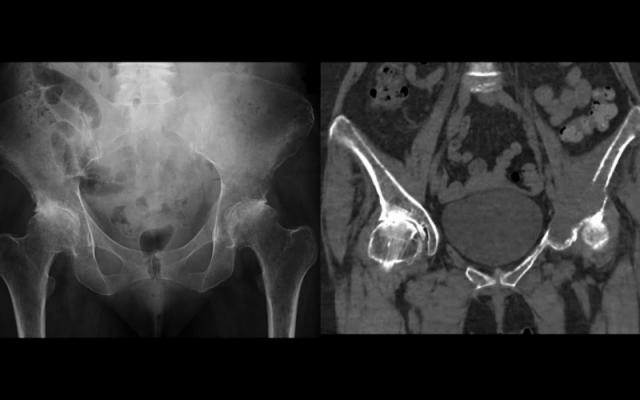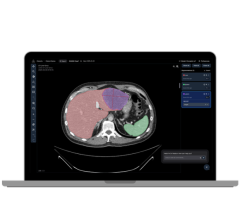
X-ray images such as the one on the left fail to indicate many cases of advanced bone destruction caused by multiple myeloma, says the author of new guidelines on imaging for patients with myeloma and related disorders. Image courtesy of Roswell Park Comprehensive Cancer Center.
June 17, 2019 — An International Myeloma Working Group (IMWG) has developed the first set of new recommendations in 10 years for imaging techniques to help diagnose multiple myeloma and other plasma-cell disorders.
Just as newer drugs have significantly improved outcomes for patients with multiple myeloma in the past decade, newer imaging techniques are upgrading detection of the disease, leading to earlier treatment. But standards to help guide clinicians on the optimal use of advanced imaging have lagged behind until now.
Jens Hillengass, M.D., chief of myeloma at Roswell Park Comprehensive Cancer Center in Buffalo, N.Y., led the IMWG effort to compile new recommendations for imaging techniques that offer more sensitive and accurate diagnosis and monitoring for patients with multiple myeloma and other plasma-cell disorders. Multiple myeloma — the second most common type of blood cancer — occurs when white blood cells known as plasma cells multiply out of control.
“Use of newer imaging techniques is changing the whole landscape, from diagnosis to treatment to supportive care to survivorship, and all those things are coming into this direction of research in multiple myeloma right now,” said Hillengass.
Hillengass and a team of two experts developed the guidelines, which were then reviewed by the entire working group. Their findings have been newly published in the journal The Lancet Oncology.1
The guidelines are based in part on an examination of results of computed tomography (CT) and X-ray imaging from several countries. The team found that using only conventional X-ray misses 25 percent of instances where patients have bone destruction already and need treatment.
“There has to be destruction of 30-50 percent of the bone, sometimes up to 70 percent, before you see anything on X-ray,” said Hillengass, who is first author on the new guidelines. “More sophisticated imaging is necessary not only in the beginning to assess the disease but also to assess the response and to see what is left after our standard treatment. Myeloma is a disease that can cause focal and diffuse destruction of the bone, and to see that, you need sharp imaging.”
The major change in the new imaging guidelines is that whole-body low-dose CT replaces conventional skeletal survey as the standard imaging technique recommended for assessing bone destruction. The IMWG team recommends that this more sophisticated technique and others, including positron emission tomography-CT (PET-CT) and magnetic resonance imaging (MRI) be introduced generally into clinical practices.
These practices are already employed in the clinical care of myeloma patients at Roswell Park, and a team at the cancer center is conducting a clinical trial to explore what CT-guided biopsies of focal lesions may reveal about the spatial and temporal heterogeneity of this disease.
Hillengass hopes that broader application of these newer techniques will lead to more refined imaging, more accurate diagnoses, earlier treatments and more patients living longer due to lasting remissions.
“There’s a lot of research underway now exploring whether incorporating more specific traces or dyes into various imaging techniques will be beneficial, and also to figure out how we can assess minimal residual disease, or very low tumor burdens after treatment,” he noted. “Therefore, we need much higher sensitivity and also functional information that cutting-edge imagery can provide. There are important questions still to be asked as these technologies evolve.”
The International Myeloma Foundation formed the IMWG in 2001 to encourage dialogue and collaboration among the world’s leading myeloma experts. The group includes 243 members from 39 countries who collaboratively conduct research to improve outcomes of the disease and provide scientifically valid consensus opinions regarding its diagnosis and treatment.
The paper, “International myeloma working group consensus recommendations on imaging in monoclonal plasma cell disorders, is available online.
For more information: www.sciencedirect.com
Reference
1. Hillengass J., Usmani S., Rajkumar S.V., et al. International myeloma working group consensus recommendations on imaging in monoclonal plasma cell disorders. The Lancet Oncology, published online May 29, 2019. https://doi.org/10.1016/S1470-2045(19)30309-2


 December 10, 2025
December 10, 2025 









